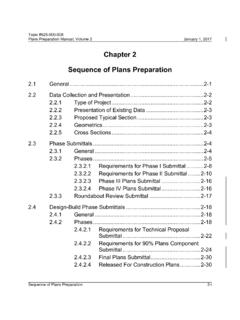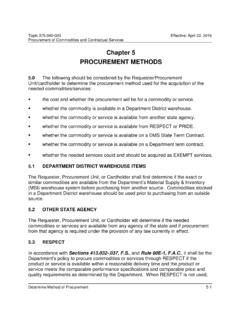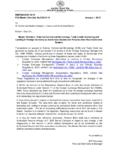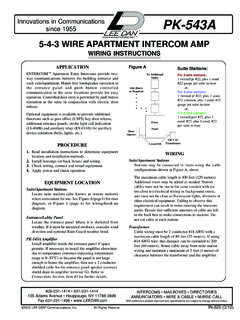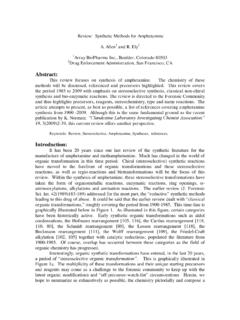Transcription of ADA* for Roadway Design
1 ADA* for Roadway Design Incorporating PROWAG**. * Americans with Disabilities Act ** Public Rights of Way Accessibility Guidelines Dean Perkins, Architect ADA Coordinator Florida Department of Transportation Introduction Brief overview of ADA. How ADA impacts Roadway projects Features of Accessibility New Concepts Examples of Roadway elements Random images Some good; some not so good How you can comply Background of the ADA. 1990 Americans with Disabilities Act July 26, 1990 - signed January 26, 1992 effective date July 1, 1994 Revised ADA Standards. July 26, 2004 new ADA guidelines (ADA/ABA). Nov 23, 2005 new PROW guidelines (PROWAG). Nov 26, 2006 FHWA adopts ADA Standards for Transportation Facilities (ADASTF). July 23, 2011 Access Board issues NPRM for PROWAG. Latest News: Final Rule due out late 2016? USDOT adoption in early-mid 2017??? The Future of Facilities within Public Rights of Way(?)
2 USDOT / FHWA recommends using PROWAG criteria where ADA Standards do not address an issue. RECOMMENDATION: Start learning PROWAG! Transportation . Roadside Accessibility Accessible Route Requirements (PROWAG Pedestrian Access Route). Widths Running slopes Cross Slopes Surfaces Changes in Level Gaps / Grates Protruding Objects Signs & Equipment, Landscape Materials, etc. Accessible Route (AR) &. Pedestrian Access Route (PAR). AR = 36 continuous unobstructed path PAR = 48 (FDOT Stds. & PROWAG). AR = 32 min. at a point' (24 max.). PAR = 48 (FDOT Stds. & PROWAG). 60 x 60 passing space @ 200'. max. 24 . 32 . 48 Min. Min. Slopes: 1:20 ( 5%) is not a ramp >1:20 (>5%) is a ramp 1:12 ( ) max. allowed *. Cross-slope 1:50 (2%) max. allowed *. 1:75 ( ) best practice 48 Min. * Exceptions in PROWAG. Pedestrian Access Route (PAR). Continuous Width The minimum continuous and unobstructed clear width of a pedestrian access route shall be 4 ft.
3 , exclusive of the width of the curb Measure from back of curb! 4'. The Sidewalk Zone' System Curb Zone Furniture Zone Pedestrian Zone (PAR). Frontage Zone Zone System: Residential Furniture Pedestrian Zone Zone (PAR). Zone System: Commercial Street Parking Furniture Pedestrian Zone (PAR). Zone Furniture Zone Carefully arranged street furniture leaves the sidewalk clear Randomly arranged street furniture clutters the sidewalk and creates an obstacle course'. A difference between AR & PAR! For sidewalks within the public right of way .. Sidewalk grade ADASTF vs. PROWAG. ADASTF: Provide accessible route (AR). PROWAG: Match Roadway grade (PAR). ADASTF PROWAG. Ramps supported slopes . , Bridges 5' min. 30' - 40' max. 5' min. Level means: Top/Interim Depending on slope (see Bottom Landing 2% or less slope Landing below). 30 Max. Sidewalks Are Pedestrian Access Routes (PAR).
4 48 min. width FDOT Design Standards Index 310. PROWAG Section R302. Cross-slopes 1:48 / 2% max. Check Surfaces Firm, Stable, Slip-resistant . Look for Level changes / . Look for Protruding Objects 27 -80 . (4' min.). (4' min.). Curb Ramps Running Slopes (1:12 / max.). Cross-slopes (1:48 / 2% max.). Landing at top (48 min.). Detectable Warnings X = 48 min. 12. Curb Ramp Grade R304. Least slope possible is preferred Recommended maximum grade to allow for construction tolerance Maximum grade Exception: when chasing grade, curb ramp length need not exceed 15', but slope must be uniform Up to 15'. Transportation . Curb Ramps and Detectable Warnings Curbs are an 'edge cue' for pedestrians who are blind or have low vision Curbs are a barrier for persons in wheelchairs Curb ramps remove the barrier for wheelchairs Curb ramps remove the edge cue for pedestrians with vision impairments Detectable warnings are a replacement cue to indicate location of the street Perpendicular Curb Ramps Perpendicular Curb Ramp Place DW at back of curb or at grade break Ramp 24.
5 Directional/Linear Ramps Greater than 5 feet setback .. Place DW on bottom landing if level landing is more than 5' deep at any point Ramp > 5'. Directional/Linear Ramps Equal to or less than 5 feet setback from bottom of curb ramp .. Place DW at grade break if level landing at bottom of ramp is 5' deep or less 5'. Ramp Parallel Ramps Ramp Ramp LANDING. 24 . Detectable warning = Stop sign'. Delineates the edge of the street Does replace missing edge cue ( , curb) for a pedestrian who is blind or visually impaired Does not designate the best place to cross Does not provide alignment information Detectable Warning Alignment To align or not to align .. Detectable warnings warn' of Roadway edge DW alignment generally NOT used as directional cue Other methods: traffic sounds, return curbs, APSs, etc. In a perfect world, all detectable warnings would be aligned with crossing Easier to construct Easier to use However.
6 Not all curb ramp configurations and site conditions permit DW alignment Detectable Warning Alignment To align or not to align .. So . Dome alignment is desirable, but not required Perfect World Real World Pedestrian Controls R306 & MUTCD In reach ranges (48 max.). 42 FDOT Standard 10 max. reach - over obstruction/edge of sidewalk 2 dia. raised buttons Maneuvering space (30 x 48 min., level). 3'-6 . Accessible Pedestrian Signals MUTCD For pedestrians with vision impairments Used in conjunction with pedestrian signal timing Add non-visual information: Tactile features Audible tones Vibrating surfaces Speech messages Must indicate which crossing is served by each device Accessible Pedestrian Signals Speakers Tactile Arrows Pushbutton Locations R403 & MUTCD 4E. NOTE: It must be clear which button controls which crossing. (per MUTCD). If APSs cannot be placed at least 10' apart, they must speak' to you.
7 Pedestrian Crossings R306. Cross Slope of crossing: STOP' or YIELD - controlled: 2% max. Traffic signal or no control: 5% max. Mid-block: Match grade of Roadway This is who we are working for RRFB. Rectangular Rapidly Flashing Beacon Upon activation of push button . HAWK. Pedestrian Hybrid Beacon Stays dark for vehicles and solid 'hand' for pedestrians until activated, then . For vehicles: 1. Flashing Yellow light, 2. Solid Yellow light, 3. Solid Red lights 4. Alternating Red lights, 5. Then dark For pedestrians: 1. Solid Hand, 2. Solid Hand, 3. Solid Walk, 4. Flashing Hand 5. Solid Hand Bus Stops R308. When siting a new bus stop . Must be on PAR. 48 min. 60 recommended This may be sidewalk or paved shoulder Must have accessible approach to bus stop 48 min. width 60 recommended Leads to / part of boarding & alighting area Meets running slope/cross slope criteria Firm, stable & slip-resistant Must consider potential construction of boarding and alighting area & other features Bus Stops If provided Boarding & Alighting area: Place for bus lift/ramp to deploy Firm, stable and slip-resistant surface 5' x 8' B&A area (ADAS & PROWAG).
8 Firm and stable surface (ADASTF). Must connect to streets, sidewalks, etc. Sidewalks, shoulders, curb ramps, etc. 5' min. width parallel to Roadway 8' min. depth perpendicular to Roadway NOTE: If low-floor, ramp-equipped bus is used, the B&A. area should be raised (curb height). Rural bus stops Primary Issues: Flush shoulder No curb/gutter Shoulder is sloped away from the Roadway Most kneeling' buses are designed to deploy front ramps onto 6 high curbs 1:4 max. slope allowed on ramp deployed on curb (ADAASTV*). Use on flush shoulder causes ramp to be too steep for safe use * ADAASTV = ADA Accessibility Specifications for Transportation Vehicles o 1:4 when 3 above 6 curb o 1:6 when >3 6 above 6 curb o 1:8 when >6 9 above 6 curb o 1:12 when >9 above 6 curb Bus Ramp & Lift Design High-floor bus with lift at rear door Lift May be deployed on 6 high curb or at ground level level platform.
9 Bus Ramp & Lift Design Low-floor bus with ramp at front door Probably the most common 4-12 <3. 1 1. Ramp: Designed to be deployed on Ramp: Deployed at ground level is 6 high curb to provide 1:4 or less too steep 1:3 slope steeper. slope. (Max. allowed under ADAASTV). Rural bus stops Parking Accessible space Width = 12'-0 min. Access aisle Width = 5'-0 min. Curb ramp Outside space & aisle Slopes 1:48 max. any direction On-Street Parking Spaces R214 & R309. Accessible on-street parking space per block perimeter approx. 4% of total Table R214. Parking spaces are best located where the street has the least crown & grade and close to key destinations ( , near crosswalks). Alternate Pedestrian Routes R205 & R303 & MUTCD 6D & 6G. Alternate Pedestrian Access Routes are required when existing pedestrian access routes are blocked by construction, alteration, maintenance, or other temporary condition.
10 You should be using these . Alternate PARs Especially, this one! See similar requirements in FDOT Index 660. Alternate PARs R205 specifies that the alternate pedestrian access route shall be: Provided on the same side of the street as the disrupted route, to the maximum extent feasible Where exposed to adjacent construction, traffic or other hazards, shall be protected with a pedestrian barricade or channelization device Continuous, stable, non-flexible Consist of features identified in the MUTCD Chapter 6F. Plastic tape is not acceptable!!! Rows of barrels and/or cones is not acceptable . unless they are connected by a continuous detectable' edge Longitudinal Channelizing Devices (LCDs). Hand Trailing Edge Detectable Edge 12. For pedestrian longitudinal channelizing devices, the device shall have a minimum of 8 continuous detectable edging above the walkway.

